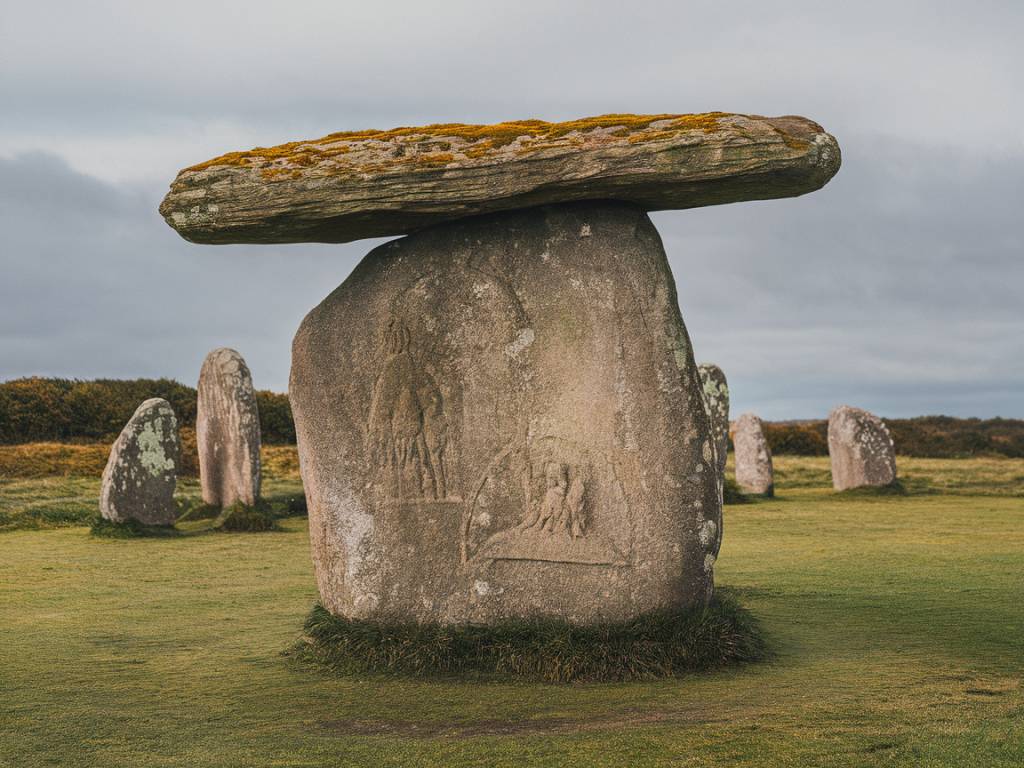The stories behind Wales’ ancient standing stones

The stories behind Wales’ ancient standing stones
The Mysteries of Wales’ Standing Stones
Walk through the rolling landscapes of Wales, and you’ll find yourself surrounded by whispers of the past. Dotting the countryside, perched atop windswept hills, or hidden in forest glades stand the ancient monoliths of Wales – the standing stones. Silent sentinels of history, these stones have captured imaginations for centuries, leaving us questioning their origins, their purpose, and the stories they hold.
A Journey Back in Time
Standing stones, or « megaliths, » are among the oldest human-made structures in Wales. Their origins date back to the Neolithic period, around 4000 to 2500 BCE, a time when communities were transitioning from nomadic hunting to settled farming lifestyles. These stones were often erected as solitary monuments, though some are part of larger arrangements like circles or alignments.
What drove early humans to hoist these multi-ton behemoths into place? Was it for ritual purposes, a way to connect with their deities? Or were they practical markers, mapping out territory or celestial events? The truth might never fully be known, but each stone whispers hints of a distant time, begging us to ask: how much of their magic has been lost to the passage of time?
Storied Stones: Anecdotes and Legends
In Wales, these standing stones are not just archaeological relics but cultural treasures wrapped in folklore. Take Maen Llia, a broad, flat stone over three meters tall, standing alone in the Brecon Beacons. Legend has it that during a full moon, Maen Llia walks down to the nearby River Nedd to quench its thirst. Echoes of this tale leave us wondering: did ancient communities see the stones as living entities, imbued with power and personality?
Another intriguing example is the Gwal y Filiast (« Greyhound Bitch’s Lair ») in Carmarthenshire. This Neolithic burial chamber, supported by massive uprights, has long been tied to stories of spectral hounds that roam the surrounding lands. Such legends entwine mythology with monuments, blending cultural identity with physical landmarks.
The Purpose Behind the Stones
Each standing stone serves as a riddle for modern archaeologists. While definitive answers remain elusive, evidence points to a range of possible uses:
- Astronomical markers: Many stones align with solstices or equinoxes, suggesting they played a role in early astronomy. For instance, some believe the Cerrig Duon stones in Powys align with lunar cycles, serving as a calendar of sorts.
- Ritual significance: Some stones, especially those near ancient burial chambers, may have been focal points for ceremonies or spiritual gatherings. Their proximity to burial sites suggests a link with honoring the dead or appeasing spirits.
- Territorial markers: In an age without fences or maps, standing stones could have demarcated boundaries, serving as enduring landmarks for communities.
Their purpose likely shifted with time, adapting to meet the evolving needs of those who lived in their shadow.
The Art of Stonework
What’s truly remarkable is the sheer effort involved in creating and positioning these monuments. Without modern tools or machinery, ancient builders had to rely on ingenuity and shared labor. Pulling stones from quarries, shaping them with rudimentary tools, and transporting them over uneven terrain required immense dedication. The very act of creating these stones may have been as important as their functions, strengthening community bonds and identity.
Standing Stones as a Window to Welsh Identity
More than mere remnants of the past, standing stones are deeply woven into the cultural tapestry of Wales. They evoke a sense of place, serving as timeless connections between the present and the ancient world. The fact that they continue to inspire local legends and modern curiosities underlines their importance in Welsh heritage.
Visiting these stones today isn’t just an outdoor excursion – it’s stepping into a living history lesson. Whether you’re pondering their alignment with celestial bodies or simply marveling at their stoic presence, standing stones invite you to become a small part of their enduring story.
Embarking on Your Own Journey
Why not step into the footsteps of ancient Welsh communities and visit some of these incredible sites? Here are a few standing stones to add to your itinerary:
- Maen Llia: After admiring this striking solitary stone, you can explore the surrounding Brecon Beacons for more Neolithic traces.
- Cerrig Duon: A lesser-known gem in Powys, this alignment of stones offers stunning landscapes and a hint of lunar lore.
- Bryn Cader Faner: Situated in Snowdonia, this Bronze Age circle of stones is as atmospheric as it is mysterious.
- Gwal y Filiast: Step into both history and legend in Carmarthenshire with this hauntingly beautiful burial chamber.
Don’t forget to bring a notebook, a camera, and a sense of curiosity – you never know what stories the stones might reveal to you.
The Evergreen Allure of Ancient Stones
In a world dominated by rapid technological progress, there’s something grounding about standing before a monolith that has weathered millennia. Wales’ standing stones remind us of our connection to the land and the enduring power of human creativity. They invite us to pause, reflect, and travel back to an age where every stone had a story – and maybe, just maybe, uncover its whisper for ourselves.





